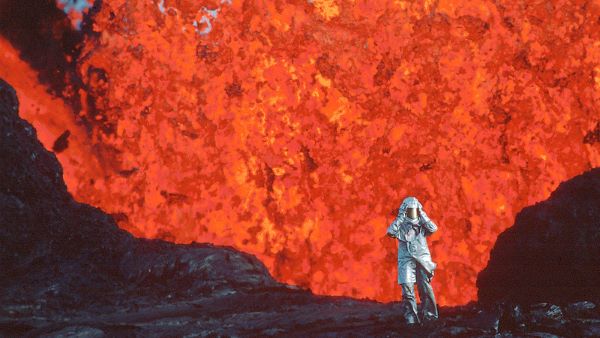We know from the start: This will not end well. Two lovers with a shared passion for up-close and personal investigation of volcanoes, on an obsessive worldwide hunt for the next eruption, could not possibly emerge unscathed.
In Fire of Love, which premiered at Sundance 2022 and now is part of this year’s New Directors/New Films lineup, director Sara Dosa builds a narrative and recounts the love story of married volcanologists Katia and Maurice Krafft through their archives, including more than 200 hours of footage (now restored and reassembled). From the outset, we know that the pair will meet their fate during the course of the documentary, and suspense builds in how and when it will happen.
The two grew up in post-World War II Alsace, France, and met in 1966. For 25 years, the eccentric pair put themselves in harm’s way in their quest for active volcanoes, with full knowledge of the deadly hazards involved. He, a burly geologist with a mop of curls who preferred a “kamikaze existence,” and she, a geochemist with a pixie haircut and glasses who would “flirt with death,” were singular as a couple among their peers in this pursuit. They could not imagine living another way.
With an atmospheric electronic soundtrack by Nicolas Godin of Air and the evocative, monotone narration by filmmaker Miranda July, appropriate for a film about an unconventional couple, the story is interspersed with Lucy Munger’s animated graphics that explain some of the technical details of the Kraffts’ geological study. For example, a volcano is a rupture in the earth’s crust that discharges lava, fumes, or ash. Tectonic plates shift, often underwater, to create the beast. Counterintuitively, the red volcanic eruptions are safer. Underground magma formed by molten rock becomes lava when it flows to the earth’s surface via a volcano. The grey ones emit burning ash and are lethal, such as Washington State’s destructive Mount St. Helens in 1980.
Adding to the eccentricity of the 93-minute film are the spectacular panoramic and close-up images of oozing lava, spewing smoke, bubbling gases, and violent flames in brilliant hues, such as scarlet and gold. Bill Morrison’s avant-garde film Decasia: The State of Decay comes to mind, with comparable beauty in destruction—in that case as archaic celluloid melts, splits, and disintegrates. Here too is a mesmerizing visual treat. For that reason, Fire of Love should be viewed on the biggest screen possible.
With the couple wearing silver suits that evoke astronauts and rocky terrain that could resemble another planet, some scenes could be mistaken for a science fiction movie. The mysteries that the couple unveil add to the space odyssey impression. However, the genre shifts, and the film takes a comedic turn when Maurice fries eggs on a cooling volcanic rock and the couple and their colleagues clown around in home movies.
The last known shot of the Kraffts in June 1991 evokes the proverb, “Live by the sword, die by the sword,” as the pair head for Japan’s Mount Unzen to what they believe is a safe distance. It is a grey eruption that can be as unpredictable as an avalanche slide of deadly fumes. In a bittersweet coda, thousands of lives were saved because the Kraffts helped to convey earlier warnings about the leviathan. Though they seemed to live to chase the next thrill, what endures is their research and humanitarian work in safeguarding populations through alert systems and evacuation plans.
Fire of Love will be released later this year by National Geographic.







Leave A Comment